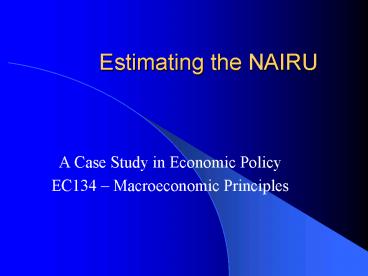Estimating the NAIRU - PowerPoint PPT Presentation
1 / 19
Title:
Estimating the NAIRU
Description:
S = supply-side factors. Some Algebra. Redefine the mark-up equation in terms of wage inflation. ... Supply-Side Effects. President Nixon's wage & price ... – PowerPoint PPT presentation
Number of Views:118
Avg rating:3.0/5.0
Title: Estimating the NAIRU
1
Estimating the NAIRU
- A Case Study in Economic Policy
- EC134 Macroeconomic Principles
2
Potential Output theNon Accelerating Inflation
Rate of Unemployment
P
LRAS
SRAS(Pe)
P
AD(PG,T,Ms)
Y
Y
3
Analytical Framework
- Construct a Phillips Curve equation from which we
can estimate the NAIRU for the United States. - If we know the NAIRU, we can make inferences
about the appropriate direction of fiscal and
monetary policy.
4
Phillips Curve 1
w a0 pe a1UR a2PROD
w wage inflation pe expected inflation UR
unemployment rate PROD productivity growth
5
Define a Mark-up Equation
- Assume that the rate of price inflation is
determined by the rate of change in unit labor
costs and other supply-side factors. - These factors can take the form of import price
shocks and wage price controls.
6
Unit Labor Costs
- Define unit labor costs as the difference between
wage inflation and the growth in labor
productivity. - Intuition high productivity growth implies lower
per unit costs of labor.
7
Mark-up Equation
- p w PROD S
- p price inflation
- w wage inflation
- PROD rate of growth of labor productivity
- S supply-side factors
8
Some Algebra
- Redefine the mark-up equation in terms of wage
inflation. - Then substitute that into the wage-price Phillips
Curve. - To produce a price-price Phillips Curve that can
be estimated econometrically.
9
Phillips Curve 2
- p a0 pe a1UR b1PROD b2S e
- Hypotheses
- a1 lt 0 Unemployment/Inflation tradeoff.
- b1 lt 0 Productivity-enhancing technical change
lowers structural inflation. - Supply shocks correspond to upward adjustments to
SRAS.
10
Long-run
- No supply shocks.
- There is some trend rate of growth for labor
productivity. - p pe, i.e., inflationary expectations are borne
out. - Long-run Phillips Curve is inelastic.
11
Solving for NAIRU
- Steady-stating this equation means setting p
pe and solving our price-price Phillips Curve
equation for the long-run value of UR. - UR (a0 b1PROD) / -a1
12
Estimation Issues
- Sample period.
- Measuring inflation.
- Measuring labor productivity.
- Identifying supply-side phenomena.
- Modeling expectations.
13
Sample Period Issues
- Structural changes to the economy alter the trend
rate of growth of productivity. - Most recent productivity enhancements have
occurred too recently to provide enough
historical experience to produce reliable
estimates. - Use as much historical data as possible.
14
Measuring Inflation
- PCE price index
- 2000 100
- Broad measure of consumer price inflation
15
Measuring Productivity
- BLS has made recent efforts to improve
productivity estimates. - Service sector productivity very difficult
conceptually and from a practical standpoint. - Use total non-farm business sector.
- An index 1992 100.
16
Supply-Side Effects
- President Nixons wage price controls.
- Oil price shocks.
- Import price inflation less core CPI inflation.
- Assume all are equal to zero in the long-run.
17
Expected Inflation
- Assume a simple, adaptive expectations model.
- Weighted average of past inflation rates.
- People predict inflation based on past
experience.
Weights (gi) sum to 1.02.
18
Econometric Results
p 2.105 1.0pe 0.035PROD 0.079(pm- pc)
1.366NIXON 0.279NIXOFF 0.350UR
- Check interpretation of coefficients
- Check statistical significance
- Calculate implied NAIRU estimates
19
NAIRU Estimate
- Depends on your assumption about the trend rate
of growth of labor productivity. - Use CEA 2004 ERP forecast of 2.1
- NAIRU 5.8






























